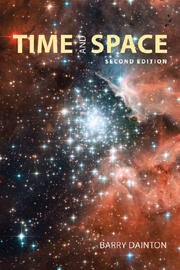Book contents
- Frontmatter
- Contents
- Preface to the second edition
- Preface to the first edition
- 1 Preliminaries
- 2 McTaggart on time's unreality
- 3 The Block universe
- 4 Asymmetries within time
- 5 Tensed time
- 6 Dynamic time
- 7 Time and consciousness
- 8 Time travel
- 9 Conceptions of void
- 10 Space: the classical debate
- 11 Absolute motion
- 12 Motion in spacetime
- 13 Curved space
- 14 Tangible space
- 15 Spatial anti-realism
- 16 Zeno and the continuum I
- 17 Zeno and the continuum II
- 18 Special relativity
- 19 Relativity and reality
- 20 General relativity
- 21 Spacetime metaphysics
- 22 Strings
- Notes
- Glossary
- Web resources
- Bibliography
- Index
17 - Zeno and the continuum II
- Frontmatter
- Contents
- Preface to the second edition
- Preface to the first edition
- 1 Preliminaries
- 2 McTaggart on time's unreality
- 3 The Block universe
- 4 Asymmetries within time
- 5 Tensed time
- 6 Dynamic time
- 7 Time and consciousness
- 8 Time travel
- 9 Conceptions of void
- 10 Space: the classical debate
- 11 Absolute motion
- 12 Motion in spacetime
- 13 Curved space
- 14 Tangible space
- 15 Spatial anti-realism
- 16 Zeno and the continuum I
- 17 Zeno and the continuum II
- 18 Special relativity
- 19 Relativity and reality
- 20 General relativity
- 21 Spacetime metaphysics
- 22 Strings
- Notes
- Glossary
- Web resources
- Bibliography
- Index
Summary
The “Arrow”
Imagine an arrow in flight. At every instant during its flight, the arrow is at some specific location, occupying a volume of space that corresponds exactly to the arrow's own size. Since instants are durationless, and motion takes time, the arrow is not in motion at (or during) these instants. Yet the arrow's entire flight is composed of these instants, and nothing but these instants. If the arrow is not in motion at any of the instants that jointly make up its flight, it is not in motion at all.
This is Zeno's “Arrow” paradox. The reasoning obviously generalizes – what holds for the arrow holds for any object in motion – and so if the argument is sound, motion does not and cannot occur. The argument is sometimes taken as being directed – along with “Stadium”, which we will be looking at shortly – against the doctrine that space and time are discrete, rather than continuous. While this may well be true for the Stadium, it is not obviously true in the case of the Arrow. In any event, the Arrow reasoning certainly poses a significant problem for those who believe space and time are continuous rather than discrete, the conception of the continuum with which we are currently concerned. If space and time are composed of dimensionless points, and the arrow's flight involves its occupying a continuous succession of different locations, we are undeniably confronted with the problem of explaining how it is possible for the arrow to have moved, given that it is not (seemingly) moving during any of the momentary stages which constitute its flight.
- Type
- Chapter
- Information
- Time and Space , pp. 289 - 312Publisher: Acumen PublishingPrint publication year: 2010



